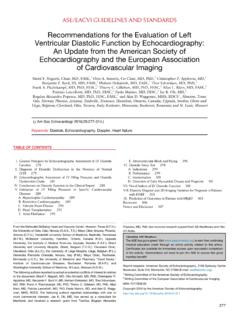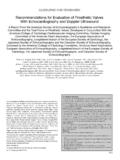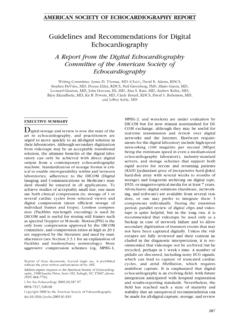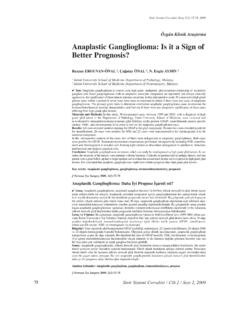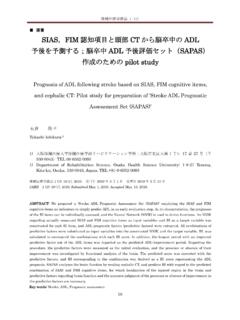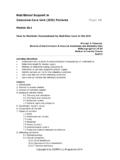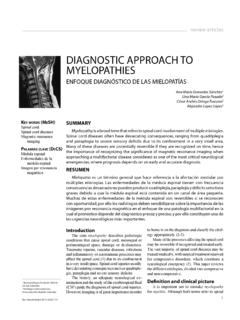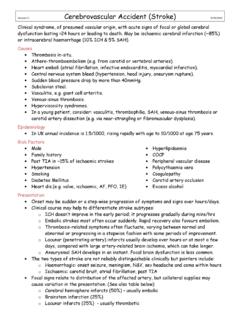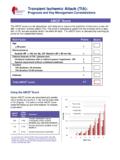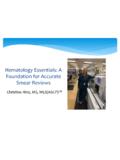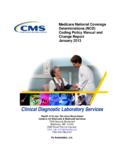Transcription of Echocardiography in Pulmonary Arterial Hypertension: from ...
1 STATE-OF-THE-ART REVIEWARTICLESE chocardiography in Pulmonary Arterial Hypertension: from Diagnosis to PrognosisEduardo Bossone, MD, PhD, Antonello D Andrea, MD, PhD, Michele D Alto, MD, Rodolfo Citro, MD,Paola Argiento, MD, PhD, Francesco Ferrara, MD, Antonio Cittadini, MD, PhD, Melvyn Rubenfire, MD,and Robert Naeije, MD, PhD,Milan, Salerno, and Naples, Italy; Ann Arbor, Michigan; Brussels, BelgiumPulmonary Arterial hypertension is most often diagnosed in its advanced stages because of the nonspecificnature of early symptoms and signs. Although clinical assessment is essential when evaluating patientswith suspected Pulmonary Arterial hypertension , Echocardiography is a key screening tool in the diagnosticalgorithm.
2 It provides an estimate of Pulmonary artery pressure, either at rest or during exercise, and is usefulin ruling out secondary causes of Pulmonary hypertension . In addition, Echocardiography is valuable inassessing prognosis and treatment options, monitoring the efficacy of specific therapeutic interventions,and detecting the preclinical stages of disease. (J Am Soc Echocardiogr 2013;26:1-14.)Keywords: Echocardiography , Pulmonary hypertension , Exercise-induced Pulmonary hypertensionPulmonary hypertension (PH) is a hemodynamic and pathophysio-logic condition defined as an increase in mean Pulmonary artery pres-sure (MPAP) of$25 mm at rest as assessed by right-heartcatheterization (RHC). It can be found in multiple clinical conditionswith distinct pathogenetic and clinical features, such as Pulmonary ar-terial hypertension (PAH) and left-heart, lung, and thromboembolicdiseases (Table 1).
3 1,2In particular, PAH is characterized by thepresence of precapillary PH due to relative blood flow obstructionproximal to the lung capillary bed and increased pulmonaryvascular resistance (PVR). This results in right ventricular (RV)pressure overload, ultimately leading to right-heart failure and has an estimated prevalence of 30 to 50 cases per million indi-viduals, affects women more frequently than men, and can be idio-pathic, heritable, drug or toxin induced, or associated with othermedical conditions, such as congenital heart disease (CHD), connec-tive tissue disease, human immunodeficiency virus infection, portalhypertension, schistosomiasis, and chronic hemolytic anemia(Table 2).3 Given the nonspecific symptoms and subtle physical signs, particu-larly in the early stages, a high clinical index of suspicion is necessaryto detect the disease before irreversible pathophysiologic changes oc-cur.
4 In this regard, transthoracic Echocardiography , by providing directand/or indirect signs of elevated Pulmonary artery pressure (PAP), isan excellent noninvasive screening test for patients with symptoms orrisk factors for PH, such as connective tissue disease, anorexigen use, Pulmonary embolism, heart failure, and heart murmurs. It may alsoprovide key information on both the etiology and the prognosisof this review, we discuss the diagnostic and prognostic role ofechocardiography in HEMODYNAMICS IN THEECHOCARDIOGRAPHY LABT able 3lists Doppler echocardiographic indices for the evaluation ofpatients with clinical suspicion of echocardiographyenables the reliable estimation of PAP, because in the absence ofpulmonary flow obstruction, tricuspid regurgitation (TR) peakvelocity (TRV) and RV outflow tract acceleration time have linearpositive and negative correlations, respectively, with systolic PAP(SPAP)
5 And MPAP measured by ,15-20,27 Furthermore,peak early diastolic and end-diastolic velocities of Pulmonary regurgi-tation correlate significantly with MPAP and Pulmonary artery end-diastolic ,18 PVR may be estimated by dividing TRV (in meters per second) bythe time-velocity integral of the RVoutflow tract (in centimeters).21,22 The rationale for this method is based on the recognition that PVR isdirectly related to pressure changes and inversely related topulmonary flow. This approach may have utility in distinguishinghigh PAP due to increased Pulmonary blood flow (as occurs inhyperthyroidism, anemia, and obesity) from PH due to elevatedPVR. An estimate of PVR may also be valuable for identifyingpatients with clinically worsening and severe PAH with no changeor a decrease in MPAP as a consequence of progressive decrease inRV ejection fraction and stroke volume (PVR = MPAP Pulmonary artery occlusion pressure/cardiac output [CO]).
6 TRV isused in daily practice to determine RV systolic pressure, which isconsidered equal to SPAP in the absence of Pulmonary outflowtract obstruction and/or pulmonic valve stenosis. This is done bycalculating the systolic transtricuspid gradient using the modifiedBernoulli equation (as simplified by ) and then addingFrom the Department of Cardiac Surgery, IRCCS Policlinico San Donato, Milan,Italy ( ); the Department of Cardiology and Cardiac Surgery, UniversityHospital Scuola Medica Salernitana, Salerno, Italy ( , ); theDepartment of Cardiothoracic Sciences, Monaldi Hospital, Second University ofNaples, Naples, Italy ( , , ); the Department of Internal Medicine andCardiovascular Sciences, University Federico II, Naples, Italy ( , ); theDepartment of Internal Medicine, University of Michigan, Ann Arbor, Michigan( ).
7 And the Department of Physiology, Faculty of Medicine ErasmeAcademic Hospital, Universit e Libre de Bruxelles, Brussels, Belgium ( ).Reprint requests: Eduardo Bossone, MD, PhD, FCCP, FESC, FACC, Via PrincipeAmedeo, 36, 83023 Lauro (AV), Italy 2013 by the American Society of assumed or calculated rightatrial pressure (RAP).9-12 Severalstudies have shown modest togood correlations betweenestimated RV systolic pressureand invasively measuredpressures (R= ),suggesting that technical andbiological variability are notnegligible. This variability isfurther reflected in thesensitivity ( ) andspecificity ( ) fordiagnosing or ruling out , to avoid false-positives, it is important to beaware that the resting physio-logic range of SPAP is dependenton age and body mass index andmay be as high as 40 mm Hg inolder (age > 50 years) or obese(body mass index > 30 kg/m2) age-related in-crease in SPAP is more commonin patients with diabetes and islikely due to Pulmonary arterynoncompliance or abnormal leftventricular (LV) diastolic fillingpressures occurring with agingand systemic hypertension .
8 Anincrease in SPAP has a negativeimpact on ,it should not be overlooked thatSPAP is a flow-dependent vari-able, such as in anemia andhypothyroidism, as a TRV of3 m/sec is easily achieved in nor-mal subjects at rest after dobut-amine few aspects must be kept inmind to ensure accurate esti-mates of SPAP. Because velocitymeasurements are angle depen-dent, TRV should be takenfrom multiple views (and offaxis if necessary), searching for the best envelope and maximal veloc-ity. Additionally, the use of color flow Doppler is recommended toobtain the best alignment between regurgitant flow and theDoppler signal. From the apical position, the transducer must be an-gled more medially and inferiorly from the mitral valve TR is present in >75% of the normal adult population, incase of a trivial regurgitant jet and a suboptimal continuous-waveDoppler spectrum, the injection of contrast agents (agitated saline,sonicated albumin, air-blood-saline mixture) may be required toachieve clear delineation of the jet ,36 Potentialoverestimation of Doppler velocities should be taken into accountbecause of contrast artifacts.
9 Furthermore, in severe TR with a largecolor flow regurgitant jet, the peak velocity may not reflect the trueRV right atrial pressure gradient because of early equalization ofRV pressure and RAP. Thus, it is recommended to gathertechnically adequate TR signals and to consider SPAP values in thecontext of the clinical scenario, searching for other concordantclinical and echocardiographic signs of pressure overload (Table 3).In this regard, the European Society of Cardiology guidelines forthe diagnosis and treatment of PH suggest to consider (1) PH unlikelyfor TRV# m/sec, SPAP#36 mm Hg (assuming RAP of 5 mmHg), and no additional echocardiographic signs of PH; (2) PH possiblefor TRV# m/sec and SPAP#36 mm Hg but the presence of ad-ditional echocardiographic signs of PH or TRVof to m/sec andSPAP of 37 to 50 mm Hg with or without additional signs of PH.
10 And(3) PH likely for TRV > m/sec and SPAP > 50 mm Hg with orwithout additional signs of FEATURES IN PULMONARYARTERIAL HYPERTENSIONF igure 1and Table 3describe echocardiographic features in of chronic RV pressure overload, at the time of diagnosis,most patients present with enlarged right-side chambers, RV hyper-trophy, increased interventricular septal thickness, an abnormal inter-ventricular septum/posterior LV wall ratio (>1), and reduced globalRV systolic function. Furthermore, the abnormal pressure gradient be-tween the left and right ventricles results in shape distortion and mo-tion of the interventricular septum ( flattening ), which persiststhroughout the cardiac a consequence, the left ventricleappears D-shaped, with reduced diastolic and systolic volumes butpreserved global systolic effusion and mitralvalve prolapse have also been described in patients with PAH.


